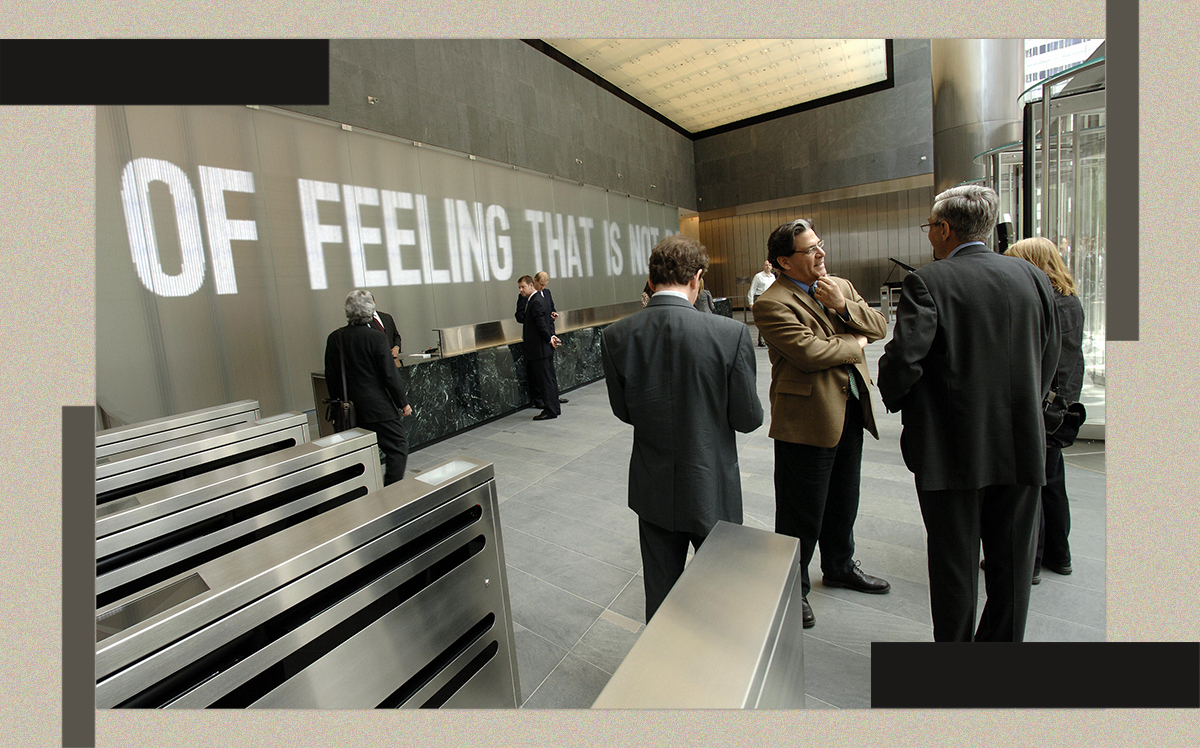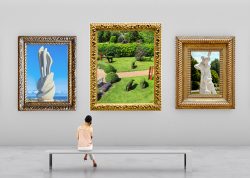
Trending
Lobbying for art

In 1933, the Rockefeller family commissioned a painting by the already world-famous Mexican painter Diego Rivera to paint a large mural for the lobby of 30 Rockefeller Plaza. Rivera’s concept for the painting that would sit in the entrance to one of the monuments to American capitalism was a piece called Man at the Crossroads. This was the center panel of a three-piece set that would put man in between the images of ethics on one side and development on the other. After some protest about the piece being used as “anti-capitalist propaganda,” the artists included the image of populist Soviet leader Vladimir Lenin. When he refused to remove the visage the director of the center, Nelson Rockefeller, ordered that it be plastered over and destroyed.
Read more



Three years later Spanish artist Josep Maria Sert was commissioned to paint a mural over that plaster which hid the Rivera controversy. The painting is called “American Progress,” and it shows Abraham Lincoln with a group of labor workers building the city’s blooming skyline. Sert made it in 1937 and its size and history made it one of the most famous works of art to sit in the entrance to an office building.
Now, walk into any office tower in Manhattan and you will see they’ve almost all followed suit–impressive paintings and art installations are in several front lobbies all over the city.
We know that artwork can be found in art galleries and museums, but what role do commercial properties have on the art scene? Curated art in commercial buildings is seeing a rise, thanks to the latest crop of art agencies that are building a bridge between the art world and real estate, bringing lobby art to an elevator near you.
Many art aficionados who want to avoid the lineups and pre-programmed time slots at museums have learned that they can just pop by certain buildings to check out their lobby art, which is free and (mostly) open to the public.
For example, Manhattan’s 2 Gansevoort showcases immersive exhibitions that change every six months and the lobby is open to the public. Meanwhile, 7 World Trade Center is home to a neon-lit digital wall by Jenny Holzer that’s called “Lobby Art” (of course) and is programmed to display poetry and quotes. 51 Astor Place shows famed works by Jeff Koons and Keith Haring in their lobby, while Andy Warhol buffs should pull out their smartphones in the lobby at 590 Madison Avenue, where a number of pop art pieces are on view, including pieces by Robert Indiana and Kenny Scharf, alongside a Warhol.
So how do these buildings acquire art in their lobby? Do they just call up an artist and they show up with a painting? Not so much.
The art agencies that service buildings are both business-minded and have a flair for aesthetics—with the art world contacts to back it up. They start out by getting to know a client’s tastes, help them develop a concept, and then acquire artworks from gallery contracts and commission pieces. Some agencies will even offer them on loan, with insurance of course.
A New York agency named Alpha’a has been helping bring artworks to commercial lobbies over the past few years. “One thing all buildings have in common is walls,” said its co-founder Manuela Seve. “You don’t want empty walls in lobbies and common spaces. We work with property owners in hospitality, commercial and residential buildings to bring art to their walls.”
But it isn’t just bringing dusty old modern paintings from the 1960s art closet to lobbies. Since buildings owe their value to their surroundings there is credibility that comes with selecting the right artist to be showcased. “We always look for local artists, and focus on minorities, like marginalized communities, Latin, BIPOC, and women artists,” said Seve. “Photos of architectural spaces, of landmarks, buildings and historical images of other landmarks work as a homage to the city and the neighborhood. It’s about building a connection between the property to the immediate community where it stands.”
Wrapped LA is an art consulting agency based in Venice Beach, California. They help bring beautiful artworks to commercial buildings as well as other institutions like schools and hospitals. They start out by offering a meeting with one of their fine art consultants, then help arrange an artist’s work to fit in the space.
It isn’t your typical paintings on white walls. What sets Wrapped LA apart is that they offer “wall coverings,” or paintings that cover walls from ceiling to floor, for large buildings that want to make a literal creative splash, a huge artistic statement. They also help arrange murals, digital artworks, and even aluminum pieces. If you think this is anything similar to a muralist with spray paint, you would be wrong.
“The spaces we occupy and how we occupy them is changing,” said Jen Mehranvary, director of sales at Wrapped LA. “An apartment, office, or retail space is no longer just that. Creating thoughtful, immersive spaces through art installations will attract visitors who will want to come back and share them with their communities effectively fueling the cycle of engagement for these properties.”
The goal, said Mehranvary, is to give a space an identity. “Developers want to differentiate themselves and their properties,” she said. “We create custom, site-specific artwork that has been evolving since its inception, matching the evolving real estate industry.”
By no surprise, the murals are in high demand. “Requests range anywhere from tropical landscapes to classical portraiture to iconic imagery specific to the local community where a property is located,” she said. “Murals are eye-catching, cost-effective, durable, easy to install, and can dramatically enhance your space.”
But what about developers who prefer digital art? Screen-based artworks that can be changed by the hit of a button. ESI Design, an NBBJ studio, is a company that brings light and video-driven digital and media art to lobby spaces across the country, from Pittsburgh to Chicago and Los Angeles.
The firm’s head of media architecture, Emily Webster, thinks that ever-changing digital artworks in building lobbies work best because artworks don’t fade into what she calls your typical “wallpaper.” They’ve worked with Comcast, Sony, Barclays, and Warner Media, among others.
She calls digital walls in corporate spaces “media environments.” Imagine an LED billboard in Times Square, remove the flashy ads, and put on a serene animation of cherry blossom trees blooming, and you get the idea behind Webster’s project, Terrell Place in Washington, DC.
“Butterflies approach anyone who pauses in the lobby,” she explains. “Suddenly, the office becomes a place of small delights and surprises, creating a fresh and evolving workplace. Workplaces that make the most of dynamic art are not only more interesting for prospective tenants―they help tenants attract and retain talent.”
Another agency that is bringing lobby art to commercial buildings is called Standard Arts, which specializes in curating installations for public spaces, be it in hospitality or real estate. They have projects in New York City and Mexico City, they’ve collaborated with companies like Equity Office, Rockwood Capital, and Savanna Fund, among others, and are “driven to provide a public voice for the arts community.”
As part of their portfolio, they’ve matched up artists to lobbies where their art fits best. At The Bryant in New York, they brought artworks by Ana Lucia Cano, among others, complementing the sleek designed building by architect David Chipperfield, while in the lobby of 200 Fifth Avenue, artist Gustavo Prado showed his Lego paintings called Pixel Garden, which are made from actual pieces of Lego, as the building used to be the International Toy Center, honoring the building’s history.
As part of one current project on view with Standard Arts, New York artist Matt Mignanelli has his abstract artworks up now at 5 Bryant Park in midtown, where he’s showcasing six paintings through the building’s entranceway until the end of 2021 (including a commissioned mural that spans 7 by 16 feet)
“I think the opportunity to experience painting in a public space is rare, and when we do it is typically just one large work,” says the artist, Mignanelli. “Having the opportunity to present a concept through multiple works that sustain a dialogue, was crucial to the project. This project was a perfect fit, as my work deals with the relationships between structure and nature within the urban landscape.”
Showing artworks in a corporate lobby, rather than an art gallery, potentially reaches more people. “It’s a new audience for the works and it reaches many people at a moment of their day when they aren’t expecting to engage with painting,” Mignanelli explained. “I also like the way in which the barrier for entry to engage with the work is low within a public space. There is often a level of intimidation to step foot into a museum or white box gallery, and this democratizes that experience in a way.”
The artist says that developers, managers, and owners of office towers should always invest in art. “Investment in art is an investment in ideas, innovation and imagination,” said Mignanelli.
“Art has the power to bring all of that and more into a space, and completely activate it. Works of art connect us and engage us in conversations with each other that we didn’t know we needed to have,” he explains. “Mindfulness and wellness have entered into our society in a whole new way and art should be a part of that equation.”
He adds: “First impressions often matter the most, for a building, a lobby is just that.”




